Authentic Lamb Korma (Mutton Korma) recipe with tender, succulent lamb slow-cooked in an aromatic yogurt and whole spice gravy.
Lamb Korma (Mutton Korma) is a traditional Pakistani and North Indian curry made with tender, succulent lamb or mutton slow-cooked in a rich yoghurt and whole-spice gravy. This slow-braised mutton curry is mildly spicy, with a silky-smooth sauce infused with aromatic spices like cardamom, cinnamon, and cloves.
Its made for everyday dinner or special occasions, weddings and festive dinners. This korma delivers an authentic flavour that’s both comforting and elegant.
This korma recipe regularly makes round to my dinner table along with other recipes like Chicken Curry, Boneless Chicken Karahi and Authentic Chicken Korma. Therefore you can be assured that you have a tried and tested recipe at hand that’s easy to follow and delivers authentic taste.
What is Korma?
Korma, also spelled Qorma, literally means “braised meat.” This classic dish originates from Mughlai cuisine, much like other royal favourites such as Nihari, Biryani or Rogan Josh.
Lamb Korma (Mutton Korma) is a popular curry across the Indian subcontinent, known for its mildly spicy, slow-cooked flavour and luxurious texture. The tender lamb is gently simmered with golden-fried onions, creamy yoghurt, and a blend of aromatic whole spices like cardamom, cloves, and cinnamon.
In some variations, ground almonds or fresh cream are added to create an even richer, wedding-style gravy that’s perfect for special occasions.
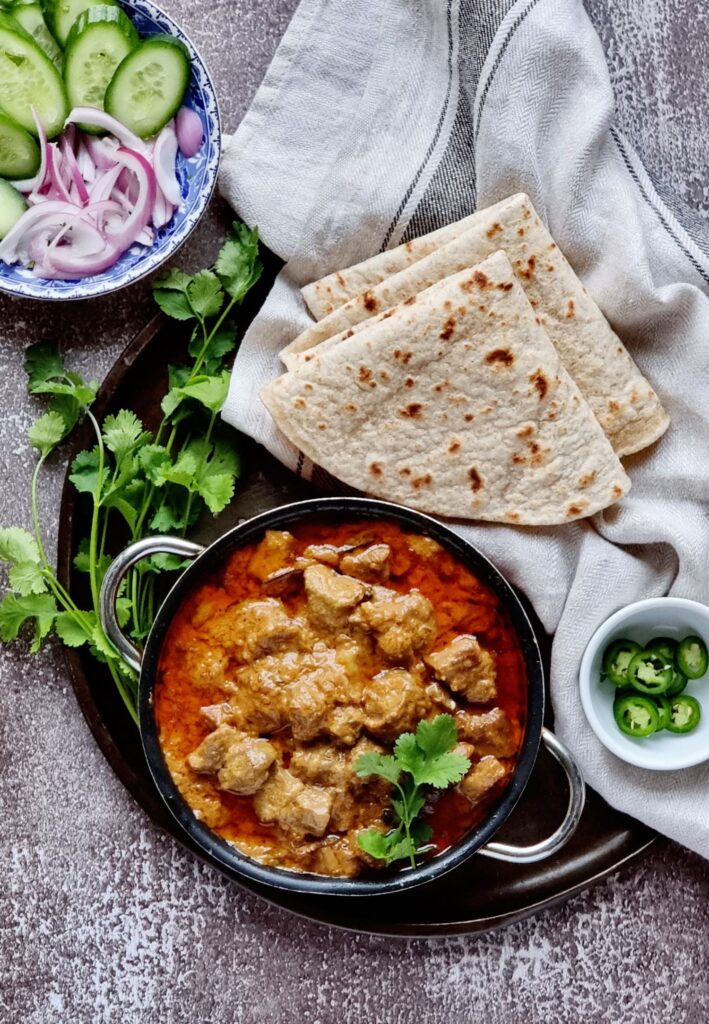
Ingredients for Lamb Korma
Lamb – Use fresh lamb curry pieces, with or without the bone, for the best flavour. Trim excess fat to keep the gravy light yet rich. You can also substitute with tender goat meat, which works beautifully in this recipe.
Yoghurt – Plain or Greek yoghurt is essential in korma, as it creates the base for the thick, creamy gravy. Unlike many curries, traditional korma does not use tomatoes, so the flavour and body of the sauce come entirely from yoghurt and golden-fried onions.
Spices – The spices can be divided into two categories:
- Aromatic whole spices – green cardamom, black cardamom, black peppercorns, cloves, bay leaves, a pinch of nutmeg powder, and mace. These give lamb korma its signature fragrance and depth of flavour.
- Regular spices – red chilli powder, Kashmiri red chilli for colour and mild heat, turmeric, cumin powder, and coriander powder.
How To Make Lamb Korma
- Fry the onions – Heat oil or ghee in a heavy-bottomed pot and fry thinly sliced onions until golden brown. Remove them from the pot and set aside.
- Temper the spices – In the same oil, add all the aromatic whole spices and let them sizzle for about a minute to release their fragrance.
- Cook the meat – Add fresh ginger-garlic paste followed by the lamb (or goat) pieces. Fry until the meat changes colour.
- Add ground spices – Stir in the remaining powdered spices and fry for 1–2 minutes. Pour in water and cook until the meat is nearly tender.
- Prepare the yoghurt-onion mixture – Using a stick blender, blend the fried onions with yoghurt until smooth. Add this mixture to the meat and stir continuously. This process, called Bhunai, helps the yoghurt combine without curdling and deepens the flavour. You’ll notice the oil starting to separate and rise to the surface.
- Simmer the gravy – Add a little water to adjust the consistency of the curry. Cover and allow it to simmer on low heat until the gravy thickens and fully absorbs the aroma of the spices.
- Finish and serve – Sprinkle garam masala over the top and garnish with fresh coriander (cilantro) before serving.
What Cut Of Meat is Ideal for Korma?
When making authentic korma, the first choice is between lamb or goat. Both work beautifully:
- Lamb – More common in Australia and many Western countries because of its tender texture and mild flavour.
- Goat (mutton) – Traditionally used in Pakistan and India. It’s leaner, lower in fat, and offers a more distinct, robust taste that stands out in rich gravies.
Whether you choose lamb or goat, the shoulder and leg cuts are the best for korma. These cuts become incredibly tender and soak up the flavours of the yoghurt, onions, and aromatic spices during slow braising.
For best results, ask your butcher to trim excess fat and cut the meat into small curry pieces for even cooking and a perfect texture in your gravy.
Can I use Pressure Cooker or Instant Pot ?
Absolutely! Both a pressure cooker and an Instant Pot are excellent for making lamb or mutton korma. Pressure cooking tenderises the meat much faster while locking in the rich flavours of the yoghurt and spices.
I’ve tried both methods — slow cooking and pressure cooking — and there’s very little difference in taste. Slow cooking develops depth of flavour over time, while pressure cooking is perfect when you need a quicker, equally delicious korma.
Watch How To Make Authentic Lamb Korma
Tips For Perfect Lamb Korma
Don’t skimp on oil or ghee – While it may seem like this recipe uses a generous amount, it’s essential for authentic flavour and texture. A distinct layer of oil floating on top is a hallmark of a perfectly cooked Pakistani or North Indian korma.
Fry onions to the right stage – Avoid over-browning the onions. Dark onions will make the gravy darker and slightly bitter. Aim for a light golden-brown colour for a rich yet balanced sauce.
Use room-temperature yoghurt – Always use yoghurt at room temperature to prevent curdling. When adding it to the pot, briefly remove the pot from the heat or turn off the stove. Stir in the yoghurt until fully combined, then return the pot to medium heat. This ensures a smooth, silky gravy without a grainy texture.
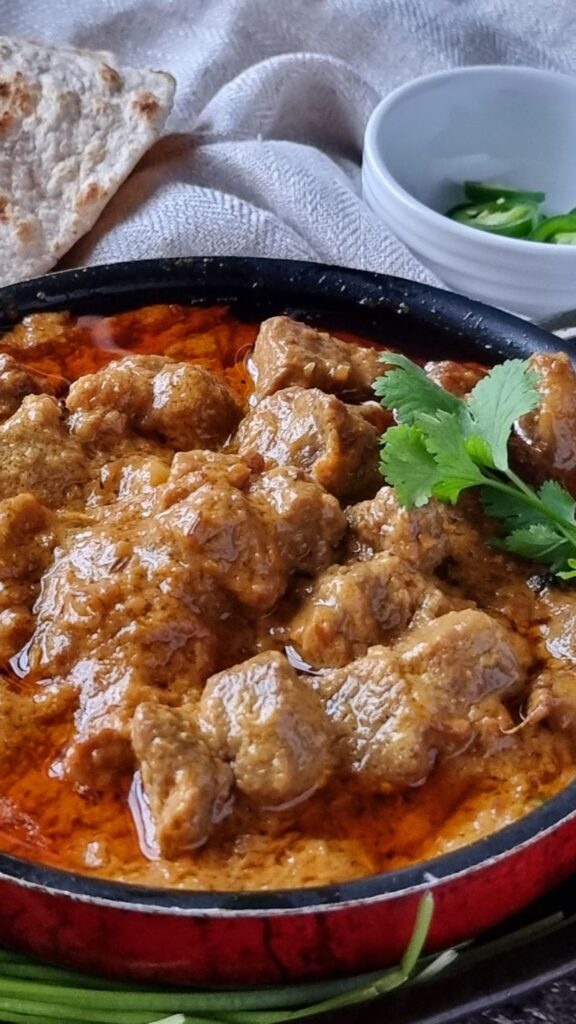
Serving Lamb Korma
Lamb Korma is best enjoyed with freshly baked naan or other soft homemade flatbreads that can soak up the rich, aromatic gravy. While some people prefer pairing it with steamed basmati rice or zeera rice, naan remains the top choice for authentic Pakistani and North Indian korma. The scrumptious sauce definitely deserves a naan to be dipped into it.
Other Curries to Try:
Do try this recipe and let me know how it turned out in the comments below! I’d love to hear your feedback.
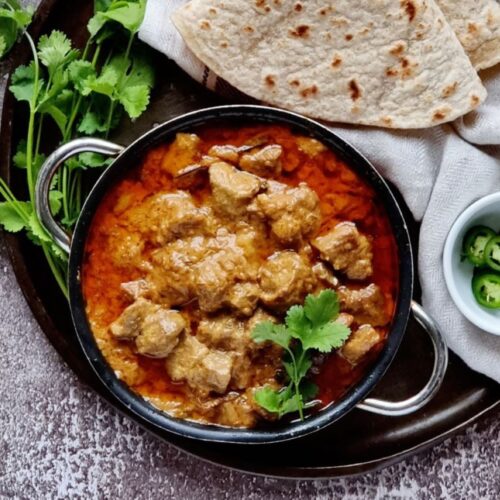
Authentic Lamb Korma
Ingredients
- 700 g Lamb(Cut Into Small Pieces) See Notes
- 1 Large Onion
- 1 Cup Plain Yoghurt See Notes
- 1 tbsp Garlic Ginger paste
- 1½ tsp Salt
- 1½ tsp Red Chilli Powder
- 1 tsp Kashmiri Red Chilli Powder See Notes
- ½ tsp Turmeric
- 1½ tsp Cumin
- 1 tbsp Coriander Powder
- 2 Bay Leaves
- 6-8 Black Peppercorns
- Pinch Nutmeg Powder
- 5-6 Cloves
- 3-4 Green Cardamoms
- 2 Pieces Mace See notes
- 1 Black Cardamoms
- 1/2 Cup Oil
- Coriander/Cilantro for garnish
- ½ tsp Garam Masala
Instructions
- In a pot, heat oil on medium flame and fry the onions until light golden brown. Remove them and place on a paper towel, and set aside.
- In the same oil, add bay leaves, cloves, black peppercorns, cumin seeds, mace, green cardamom, and black cardamom. Temper for about a minute, then add garlic-ginger paste and fry for another minute.
- Add the Meat and fry until it changes its colour.
- Add salt, red chilli powder, Kashmiri red chilli powder, turmeric, cumin powder and coriander powder. Fry the meat for around 5-7 minutes. Add a dash of water if spices are sticking to the pan.
- Once you see oil separating, add 3/4 cup of water, cover and cook for around 30 minutes if using a normal pot. If you are using pressure cooker or Instant pot cook it for 15 minutes.
- Blend the yoghurt and fried onions together using stick blender. Alternatively crush fried onions with hands and mix them in the yoghurt.
- Remove the pot from heat and add yoghurt to the meat. Stir in until well combined.
- Return it back to the heat and cook on medium flame until water from yoghurt evaporates and oil starts to separate. This step is crucial, keep stirring around to prevent the meat from sticking to the pot.
- You can add a little water to adjust the consistency of gravy. Cover and cook on low flame for 10 minutes.
- Sprinkle garam masala over the top and garnish with fresh cilantro (coriander). Serve hot with naan or roti.
Notes
- Use lamb leg or shoulder pieces and trim off excess fat for the best texture.
- Greek-style yoghurt is preferred, but pot-style yoghurt works too. Ensure it is at room temperature before adding to the curry to prevent curdling or splitting.
- Kashmiri red chilli powder is mainly for colour and does not add significant heat. Sweet paprika can be used as an alternative.
- Mace is the outer covering of nutmeg. You can use it whole or powdered, but add sparingly as it has a strong flavour that can overpower the dish.


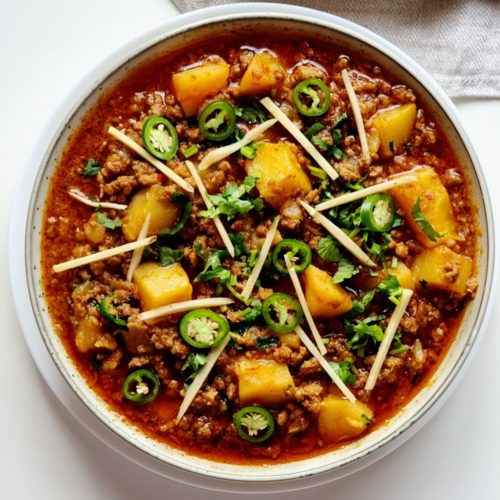

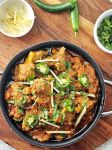


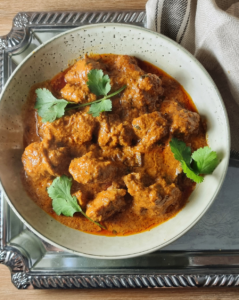
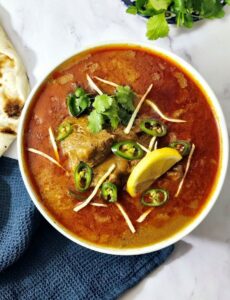
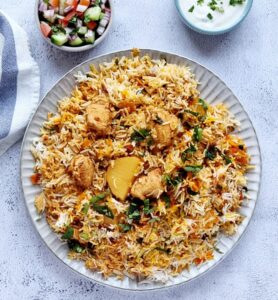
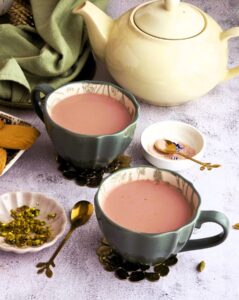
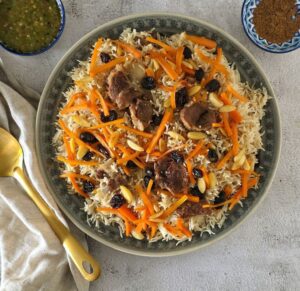
This is an amazing Korma recipe. I used goat instead of lamb, turned out perfect, balanced spices and beautifully aromatic. The recipe is literally so easy to follow and simple.
I made this recipe in the crock pot, browned the spiced meat with flour and added to the base. I also added vegetables, tomato, zucchini, pepper, mushroom , and potatoes. “Getting some veggies in my ‘meat and potatoes ‘ fiancee. The spice profile is perfect, however not spicy enough for us so went heavy on the hot peppers. I used ground instead of whole spices, it’s what I had available. Still cooking but flavor is perfect match to authentic korma. I’m making Naan and riata to accompany with tamarind and mint chutney, sure to be delicious!
Amazing and delicous korma recipe. It was so easy to make.and my family loved it. I will be.making this more often for dinner
Thats Great Amanda, thankyou for tyring this recipe.
Amazing korma recipe. I wanted to try making korma after I had it in a restaurant. It’s perfectly spiced and love the smooth sauce. I tried with naan and steamed rice. Definelty it’s better with naan I would say.
Thanks Trisha, im happy that you liked this recipe. I like it with naan too !!
This is such a good recipe of korma, it’s so easy to follow. There are no unnecessary spices, so implement and the taste is so good. It’s has that authentic aroma which is usually from restaurant korma. I’m always going to use this recipe for making mutton korma.